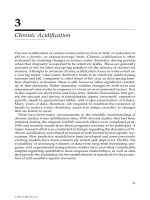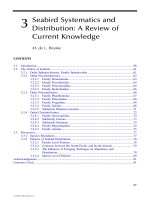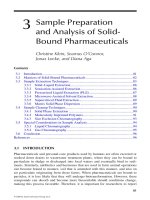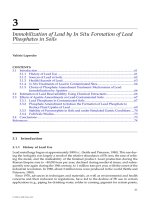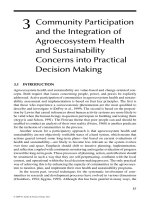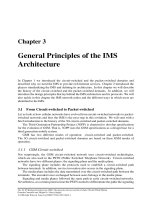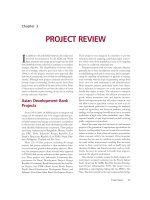Chapter 3 second law of TMD
Bạn đang xem bản rút gọn của tài liệu. Xem và tải ngay bản đầy đủ của tài liệu tại đây (1.95 MB, 63 trang )
PHYSICAL CHEMISTRY 1
Chapter 3 – Second law of TMD
Dr. Ngo Thanh An
Chapter 3 – Second law of thermodynamics
Introduction
Transferring heat
to
a
paddle
wheel will not
cause it to rotate.
A cup of hot coffee does not
get hotter in a cooler room.
Transferring heat to
a wire will not
generate electricity.
These processes cannot
occur even though they
are not in violation of the
first law.
Chapter 3 – Second law of thermodynamics
Introduction
Processes occur in a certain direction, and not in the reverse
direction.
A process must satisfy both the first
and second laws of thermodynamics
to proceed.
MAJOR USES OF THE SECOND LAW
1. The second law may be used to identify the direction of processes.
2. The second law also asserts that energy has quality as well as quantity. The first law is
concerned with the quantity of energy and the transformations of energy from one form
to another with no regard to its quality. The second law provides the necessary means to
determine the quality as well as the degree of degradation of energy during a process.
3. The second law of thermodynamics is also used in determining the theoretical limits for
the performance of commonly used engineering systems, such as heat engines and
refrigerators, as well as predicting the degree of completion of chemical reactions.
Chapter 3 – Second law of thermodynamics
Thermal energy reservoir
A source supplies
energy in the
form of heat, and
a sink absorbs it.
Bodies with relatively large thermal
masses can be modeled as thermal
energy reservoirs.
•
•
A hypothetical body with a relatively large thermal energy capacity (mass x specific
heat) that can supply or absorb finite amounts of heat without undergoing any
change in temperature is called a thermal energy reservoir, or just a reservoir.
In practice, large bodies of water such as oceans, lakes, and rivers as well as the
atmospheric air can be modeled accurately as thermal energy reservoirs because of
their large thermal energy storage capabilities or thermal masses.
Chapter 3 – Second law of thermodynamics
Heat engine
Work can always be converted to heat
directly and completely, but the reverse
is not true.
Part of the heat received
by a heat engine is
converted to work, while
the rest is rejected to a
sink.
The devices that convert heat to work.
1. They receive heat from a hightemperature source (solar energy,
oil furnace, nuclear reactor, etc.).
2. They convert part of this heat to
work (usually in the form of a
rotating shaft.)
3. They reject the remaining waste
heat to a low-temperature sink (the
atmosphere, rivers, etc.).
4. They operate on a cycle.
Heat engines and other cyclic devices
usually involve a fluid to and from
which heat is transferred while
undergoing a cycle. This fluid is
called the working fluid.
Chapter 3 – Second law of thermodynamics
Thermal efficiency
Schematic of a
heat engine.
Some heat engines perform better than
others (convert more of the heat they
receive to work).
Even
the
most
efficient heat engines
reject almost one-half
of the energy they
receive as waste heat.
Chapter 3 – Second law of thermodynamics
Can we save Qout?
A heat-engine cycle cannot be completed without
rejecting some heat to a low-temperature sink.
In a steam power plant, the
condenser is the device where
large quantities of waste heat is
rejected to rivers, lakes, or the
atmosphere.
Can we not just take the
condenser out of the plant and
save all that waste energy?
The answer is, unfortunately, a
firm no for the simple reason
that without a heat rejection
process in a condenser, the
cycle cannot be completed.
Every heat engine must waste some energy by transferring it to a lowtemperature reservoir in order to complete the cycle, even under idealized
conditions.
Chapter 3 – Second law of thermodynamics
2nd law: Kelvin-Planck statement
It is impossible for any device that
operates on a cycle to receive heat from
a single reservoir and produce a net
amount of work.
No heat engine can have a thermal
efficiency of 100 percent, or as for a power
plant to operate, the working fluid must
exchange heat with the environment as well
as the furnace.
The impossibility of having a 100% efficient
heat engine is not due to friction or other
dissipative effects. It is a limitation that
applies to both the idealized and the actual
heat engines.
A heat engine that violates the Kelvin–
Planck statement of the second law.
Chapter 3 – Second law of thermodynamics
Refrigerator and heat pump
The transfer of heat from a lowtemperature medium to a hightemperature one requires special devices
called refrigerators.
• Refrigerators, like heat engines, are cyclic
devices.
•
The working fluid used in the
refrigeration cycle is called a refrigerant.
• The most frequently used refrigeration
cycle
is
the
vapor-compression
refrigeration cycle.
•
Basic components of a refrigeration
system and typical operating conditions.
In a household refrigerator, the freezer
compartment where heat is absorbed by the
refrigerant serves as the evaporator, and the
coils usually behind the refrigerator where
heat is dissipated to the kitchen air serve as
the condenser.
Chapter 3 – Second law of thermodynamics
Coefficient of performance
The efficiency of a refrigerator is expressed in terms
of the coefficient of performance (COP).
The objective of a refrigerator is to remove heat (QL)
from the refrigerated space.
The
objective
of
a
refrigerator is to remove QL
from the cooled space.
Can the value of COPR be greater than unity?
Chapter 3 – Second law of thermodynamics
Heat pump
The objective of a
heat pump is to
supply heat QH
into the warmer
space.
The work supplied
to a heat pump is
used to extract
energy from the
cold outdoors and
carry it into the
warm indoors.
Can the value of COPHP be
lower than unity?
What
does
COPHP=1
represent?
Chapter 3 – Second law of thermodynamics
2nd law: Clausius statement
It is impossible to construct a device that operates in a
cycle and produces no effect other than the transfer of
heat from a lower-temperature body to a highertemperature body.
It states that a refrigerator cannot operate unless its
compressor is driven by an external power source, such
as an electric motor.
This way, the net effect on the surroundings involves
the consumption of some energy in the form of work, in
addition to the transfer of heat from a colder body to a
warmer one.
To date, no experiment has been conducted that
contradicts the second law, and this should be taken as
sufficient proof of its validity.
A refrigerator that violates
the Clausius statement of
the second law.
Chapter 3 – Second law of thermodynamics
Reversible and irreversible processes
Reversible process: A process that can be reversed without leaving any trace on the
surroundings.
Irreversible process: A process that is not reversible.
• All the processes occurring in nature are irreversible.
• Why are we interested in reversible processes?
• (1) they are easy to analyze and (2) they serve as idealized
models (theoretical limits) to which actual processes can be
compared.
• Some processes are more irreversible than others.
• We try to approximate reversible processes. Why?
Two familiar reversible
processes.
Reversible processes deliver the most and consume the
least work.
Chapter 3 – Second law of thermodynamics
Quá trình thuận nghịch và BTN
Quá trình thuận nghịch:
Là quá trình mà khi đi từ A đến B và ngược lại từ B đến A thì hệ không
gây ra bất kỳ sự biến đổi nào trong hệ cũng như cho môi trường.
Không gây biến đổi tức không tiêu hao năng lượng tức không có
entropy nội sinh không sinh ra entropy
Điểm chính của quá trình thuận nghịch, đó là quá trình không gây
ra biến đổi entropy!!!!
Quá trình Bất thuận nghịch: quá trình không thỏa mãn các điều kiện trên
-Đối với quá trình thuận nghịch:
- Công hệ sinh đạt cực đại Tại sao????? (liên quan hiệu suất
nhiệt cực đại)
- Công hệ nhận đạt cực tiểu Tại sao???? (liên quan giá trị COP
cực đại)
Chapter 3 – Second law of thermodynamics
Reversible and irreversible process
Chapter 3 – Second law of thermodynamics
• The factors that cause a process to be irreversible are called
irreversibilities.
• They include friction, unrestrained expansion, mixing of two
fluids, heat transfer across a finite temperature difference,
electric resistance, inelastic deformation of solids, and
chemical reactions.
• The presence of any of these effects renders a process
irreversible.
Irreversibilities
(a)
Heat
transfer
through a temperature
difference
is
irreversible, and (b) the
reverse process is
impossible.
Friction renders a
process irreversible.
Irreversible compression
and expansion processes.
Chapter 3 – Second law of thermodynamics
The Carnot cycle
►The Carnot cycle provides an example of a
reversible cycle that operates between two
thermal reservoirs.
►In a Carnot cycle, the system executing the cycle
undergoes a series of four internally reversible
processes: two adiabatic processes alternated
with two isothermal processes.
Chapter 3 – Second law of thermodynamics
The Carnot cycle
Execution of the Carnot cycle in a closed system.
Reversible Isothermal Expansion (process 1-2, TH = constant)
Reversible Adiabatic Expansion (process 2-3, temperature drops from TH to TL)
Reversible Isothermal Compression (process 3-4, TL = constant)
Reversible Adiabatic Compression (process 4-1, temperature rises from TL to TH)
Chapter 3 – Second law of thermodynamics
The Reversed Carnot cycle
P-V diagram of the Carnot cycle.
P-V diagram of the reversed Carnot
cycle.
The Carnot heat-engine cycle is a totally reversible cycle.
Therefore, all the processes that comprise it can be reversed, in which case it
becomes the Carnot refrigeration cycle.
Chapter 3 – Second law of thermodynamics
The Carnot principle
The Carnot principles.
Proof of the first Carnot principle.
1. The efficiency of an irreversible heat engine is always less than the efficiency of a
reversible one operating between the same two reservoirs.
2. The efficiencies of all reversible heat engines operating between the same two
reservoirs are the same.
Chapter 3 – Second law of thermodynamics
The Carnot principle
Chapter 3 – Second law of thermodynamics
The thermodynamic temperature scale
A temperature scale that is independent of the
properties of the substances that are used to
measure temperature is called a thermodynamic
temperature scale.
Such a temperature scale offers great
conveniences in thermodynamic calculations.
The arrangement of heat engines used to
develop the thermodynamic temperature scale.
Chapter 3 – Second law of thermodynamics
The thermodynamic temperature scale
Chapter 3 – Second law of thermodynamics
The thermodynamic temperature scale
Chapter 3 – Second law of thermodynamics
The thermodynamic temperature scale
For a reversible heat engine operating between two reservoirs at temperatures TH and TL,
the above equation can be written as
If we select φ(T) = T, then


